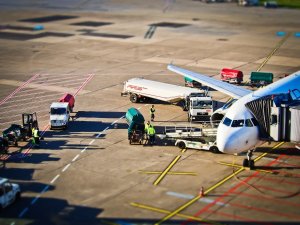
 As of 1 January 2021, fishmeal can be shipped as cargo on either a passenger or cargo aircraft as normal dangerous goods without requiring an approval. The amendment to allow the transport of antioxidant-stabilised samples of fish meal by air is identified in the changes to the 2021 IATA Dangerous Goods Regulations (see attached document in the Downloads section). Restrictions are provided for fishmeal sample size, limited to 100kg for passenger and cargo aircraft, and 200kg for cargo only aircraft. IATA has also amended its Packaging Instructions.
As of 1 January 2021, fishmeal can be shipped as cargo on either a passenger or cargo aircraft as normal dangerous goods without requiring an approval. The amendment to allow the transport of antioxidant-stabilised samples of fish meal by air is identified in the changes to the 2021 IATA Dangerous Goods Regulations (see attached document in the Downloads section). Restrictions are provided for fishmeal sample size, limited to 100kg for passenger and cargo aircraft, and 200kg for cargo only aircraft. IATA has also amended its Packaging Instructions.
IFFO has been working on ways to stabilize fishmeal when transported via vessels using different antioxidants. This has been done through amendments to the International Marine Organisation (IMO) codes. During this time, IFFO has had to move fishmeal samples for research purposes from Lima to the USA and from Lima to the UK. Time for shipping those samples has not been our best ally, hindering the possibility to move fishmeal in a faster way than a vessel. Logical is to think that we needed to resort to move this fishmeal via air. However, despite multiple attempts to transport fishmeal via couriers, freight forwarders, custom brokers, etc., we saw it as a mission impossible.
Working with the International Civil Aviation Organization
This inconvenience made IFFO to consider contacting the ICAO (the International Civil Aviation Organization, a UN specialized agency as well as the IMO) and the IATA to find out why fishmeal when stabilized with antioxidant cannot be transported via air. It turned out that this was a long-standing prohibition, that had more to do more with “wording” rather than a “real danger” in fishmeal, due to UN 2216 (Fishmeal stabilized) is classified in Class 9*. The reason for its absence from the list in the Instructions was thought to be that there was no need to transport fishmeal via air.
Our contact at the ICAO also referred that this prohibition might have been based on the classification of unstabilized fishmeal in Division 4.2**. This prohibition was originated from ICAO's Technical Instructions for the Safe Transport of Dangerous Goods via Air, having the IATA not responsible to change this.
To drive change, IFFO submitted a proposal to the ICAO Dangerous Goods Panel (DGP) to change the status of the transportation of fishmeal on both passenger and cargo aircraft when stabilized with antioxidant. This proposal included the results of trials that IFFO has been doing and that have demonstrated that when fishmeal is stabilized with antioxidant does not pose a risk for self-heating.
This proposal was presented in the DGP meeting in April 2019 in Montreal, Canada and was agreed without significant changes.
Positive outcome
These changes are incorporated into the next edition of the ICAO Technical Instructions which have become effective 1 January 2021 and you can find them on-line here. The detail of the narrative on the discussion on the working paper on fish meal is on page 12. The details of the changes to the Technical Instructions are shown on pages C-32 for the change to the list of dangerous goods and C-52 for the revision to the packing instruction.
You may watch the IATA explainer video here.
DEFINITIONS
Miscellaneous (Class 9*) is for miscellaneous dangerous items. The class does not have any subdivisions but comprises any substance that may pose a danger during air transport that isn't covered by the other classes. This includes items with anaesthetic properties, solid dry ice, asbestos, life rafts and chain saws.
Class 4 dangerous goods include flammable solids, substances liable to spontaneous combustion and substances which, in contact with water, emit flammable gases. There are three sub-divisions:
- Division 4.1: Flammable solids
- **Division 4.2: Substances liable to spontaneous combustion
- Division 4.3: Substances which, in contact with water, emit flammable gases
ΩUN special provision 300: Fish meal or fish scrap shall not be transported if the temperature at the time of loading exceeds 35°C or 5°C above the ambient temperature, whichever is higher.
http://dgca.gov.in/intradgca/intra/icaodocs/Doc%209284%20-%20Dangerous%20Goods%20Technical%20Instructions%20Ed%202011-2012%20-%20Supplement%20(En).pdf https://www.icao.int/safety/DangerousGoods/Pages/WG19.aspx
https://www.icao.int/safety/DangerousGoods/WG19/DGPWG.19.WP.030.en.pdf
Photo: Michael Gaida, from Pixabay








